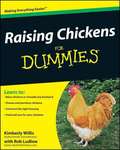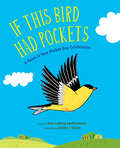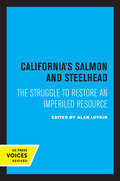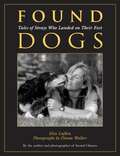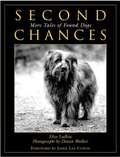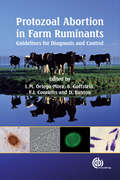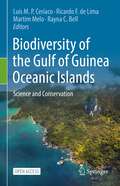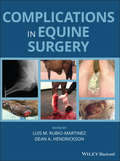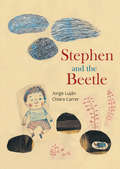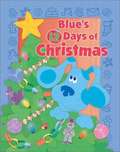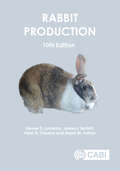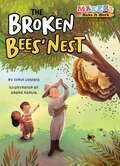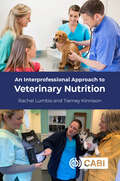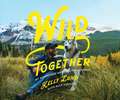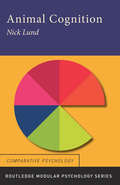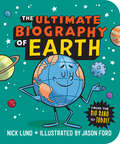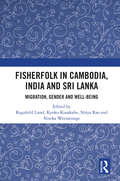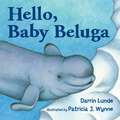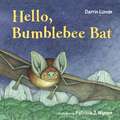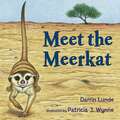- Table View
- List View
Raising Chickens For Dummies
by Ludlow Kimberly WillisPractical how-to advice for raising chickens in virtually any backyard!Raising chickens on a small scale is a popular-and growing-pastime. And Raising Chickens For Dummies provides an up-to-date, thorough introduction to all aspects of caring for chickens, including choosing and purchasing chickens, constructing housing, and proper feeding. Raising Chickens For Dummies provides authoritative, detailed information to make raising chickens for eggs, meat, or backyard entertainment that much easier.
Mouse
by Zebo LudvicekA hungry mouse discovers the alphabet, nibble by nibble, in this playful tale. When the letter M comes upon a hungry little mouse with a delicious-looking cherry, he can't help but ask for a bite. The mouse reluctantly agrees, only for the M to devour the entire thing! In exchange, the M offers the mouse some of itself, but after a few bites the M has suddenly become an N. So begins the mouse's journey through the many letters of the alphabet thanks to some creative nibbling and imaginative illustrations from debut author/illustrator Zebo Ludvicek.
If This Bird Had Pockets: A Poem in Your Pocket Day Celebration
by Amy Ludwig VanDerwaterAn ideal gift for children who love animals, this picture book is a celebration of Poem in your Pocket Day and a charmingly illustrated collection of playful poems about 19 different creatures.Fascinating information about the animals (yes, sea otters have pockets!) tucked into short, lively poems and bright, bold artwork make this collection perfect for National Poetry Month—or any day of the year.In honor of Poem in Your Pocket Day, a child imagines the poems animals might carry in their pockets, if they had pockets. What would a hummingbird write? A fox? A sea otter? These poems capture the essences of animals furry, feathery and finny, exploring what makes each unique. Ruby-Throated Hummingbird sings with its wings, Red Fox's poem is a fiery tail flashing in the dark, and Sea Otter&’s poem is its secret pocket. Which poem will capture the heart of the child narrator? A poem about loving animals, of course!
California's Salmon and Steelhead: The Struggle to Restore an Imperiled Resource
by Alan LufkinMillions upon millions of salmon and steelhead once filled California streams, providing a plentiful and sustainable food resource for the original peoples of the region. But over the years, dams and irrigation diversions have reduced natural spawning habitat from an estimated 6,000 miles to fewer than 300. River pollution has also hit hard at fish populations, which within recent decades have diminished by 80 percent. One species, the San Joaquin River spring chinook, became extinct soon after World War II. Other species are nearly extinct. This volume documents the reasons for the decline; it also offers practical suggestions about how the decline might be reversed. The California salmon story is presented here in human perspective: its broad historical, economic, cultural, and political facets, as well as the biological, are all treated. No comparable work has ever been published, although some of the material has been available for half a century. In the richly varied contributions in this volume, the reader meets Indians whose history is tied to the history of the salmon and steelhead upon which they depend; commercial trollers who see their livelihood and unique lifestyle vanishing; biologists and fishery managers alarmed at the loss of river water habitable by fish and at the effects of hatcheries on native gene pools. Women who fish, conservation-minded citizens, foresters, economists, outdoor writers, engineers, politicians, city youth restoring streambeds—all are represented. Their lives—and the lives of all Californians—are affected in myriad ways by the fate of California's salmon and steelhead. This title is part of UC Press's Voices Revived program, which commemorates University of California Press’s mission to seek out and cultivate the brightest minds and give them voice, reach, and impact. Drawing on a backlist dating to 1893, Voices Revived makes high-quality, peer-reviewed scholarship accessible once again using print-on-demand technology. This title was originally published in 1991.
Found Dogs: Tales of Strays Who Landed On Their Feet (Lyons Press Ser.)
by Elise LufkinEvery year, millions of dogs are abandoned—at animal shelters, racetracks, or on the side of the road. Many of these animals end their days without ever knowing a caring human hand, but some are fortunate enough to be found and given a second chance. And these dogs, often rescued from death’s door, seem to have even more than the usual canine capacity for love and loyalty. Found Dogs is full of wonderful photos and words by people who have adopted dogs in myriad ways. Celebrities from Peter Mayle, Jamie Lee Curtis, Al Gore, and Bobby Short to everyday heroes who have found dogs--from purebreds to scruffy mix-breeds--that have become service dogs, protectors, and friends, offering solace, aid, companionship, and inspiration. Found Dogs is a moving tribute to the power of love between people and dogs--how that love has transformed dogs who were lost, and the people who were lucky enough to find them.
Second Chances: More Tales of Found Dogs (Lyons Press Ser.)
by Elise Lufkin Diana WalkerSecond Chances is full of wonderful photos and words by people who have given dogs a second chance. Celebrities from Mikhail Baryshnikov to Oscar de la Renta and everyday heroes who have found dogs of all sorts - from sleek greyhounds to scruffy mutts - share their tales of discovery and canine-human friendship.
Protozoal Abortion in Farm Ruminants: Guidelines for Diagnosis and Control
by Luis M. Ortega-Mora Bruno Gottstein Franz J. Conraths David BuxtonProtozoal diseases cause abortion in ruminants and therefore its diagnosis is vital in improving the health and welfare of farm livestock. This book is a collective effort from international scientists involved in an EU COST Action with carefully selected methodologies, presented in a simple and practical form to enable the laboratories carry out their research with precision.
Biodiversity of the Gulf of Guinea Oceanic Islands: Science and Conservation
by Luis M. P. Ceríaco Ricardo F. de Lima Martim Melo Rayna C. BellThis open access book presents a comprehensive synthesis of the biodiversity of the oceanic islands of the Gulf of Guinea, a biodiversity hotspot off the west coast of Central Africa. Written by experts, the book compiles data from a plethora of sources – archives, museums, bibliography, official reports and previously unpublished data – to provide readers with the most updated information about the biological richness of these islands and the conservation issues they face. The Gulf of Guinea Oceanic Islands (Príncipe, São Tomé and Annobón and surrounding islets) present extraordinary levels of endemism across different animal, fungi and plant groups. This very high endemism likely results from the long geological history of the islands and their proximity to the diversity-rich continent. Many researchers, students and conservationists from across the globe are interested in documenting biodiversity on the islands, understanding the evolutionary origins of this diversity, and mitigating the impacts of global change on this unique archipelago. This book aims to be a primer for a broad audience seeking baseline biodiversity information and to serve as a roadmap for future research efforts aiming to fill knowledge gaps in understanding and conserving the unparalleled biodiversity of the Gulf of Guinea islands.
Complications in Equine Surgery
by Luis M. Rubio-Martinez Dean A. HendricksonA groundbreaking reference on complications associated with equine surgical procedures Complications in Equine Surgery is the first reference to focus exclusively on understanding, preventing, recognizing, managing, and prognosing, technical and post-procedural complications in equine surgery. Edited by two noted experts on the topic, the book presents evidence-based information using a clear approach, organized by body system. Featuring color images, the book contains detailed coverage of the gastrointestinal, respiratory, musculoskeletal, urogenital, and neurological systems. Each chapter contains a short introduction of the procedure with explanations of when and how the procedure is to be performed. All chapters review how to recognize and prevent technical complications and explain how to manage post-operative complications. This important text: Offers the first resource specifically focused on complications encountered in equine surgery Takes a helpful format organized by body system Provides consistently formatted chapters for ease of use Covers clinically relevant information for dealing with technical and post-operative complications Presents more than 350 color images to illustrate the concepts described Written for general practitioners and specialists, Complications in Equine Surgery is an essential resource to decreasing morbidity and mortality and increasing surgical success in horses.
Stephen and the Beetle
by Jorge LujánWhen Stephen spots a beetle he takes off his shoe and raises his arm, ready to strike… but then he has second thoughts. He lays his head down on the ground and the beetle walks right up to him. At the last moment the beetle turns aside and each can go on with the day, having avoided the worst.In this very simple story Jorge Luján presents the kind of deep moral questions that can occur even in the smallest child's day. Chiara Carrer's very original etched and painted illustrations perfectly complement the story, and are in and of themselves beautiful works of art.
Blue's 12 Days of Christmas (Blue's Clues)
by Catherine LukasBlue's 12 Days of Christmas: On the first day of Christmas, my friend Blue gave to me . . . a star for the top of our tree! Sing along with Blue and her friends as they lead us through their own special version of this holiday classic. Count from the first to the twelfth day of Christmas . . . and then start all over again!
Rabbit Production
by Steven Lukefahr James I McNitt Peter Robert Cheeke Nephi PattonRabbits are versatile animals, farmed for their meat and fur, as laboratory animals, and also as pets. This well-established book continues to provide an overview of domesticated rabbit production, covering topics such as breeding, husbandry, feeding and health. Now in its fully updated tenth edition, it includes an expanded consideration of important issues such as animal welfare and sustainable methods of production. With chapters relating specifically to meat production, pet rabbits, rabbit shows, and angora wool production, this new edition: - Includes new information on the latest methods of artificial insemination, estrous synchronization, embryo transfer, cloning and molecular genetics; - Tackles globally prevalent health issues such as enteritis complex (EC) rabbit enterocolitis (REC), and viral hemorrhagic disease; - Reviews up-to-the-minute developments such as the impact of the covid-19 pandemic on food production, as well as new projects addressing poverty alleviation and food security. Providing updates on worldwide production trends, figures and new feed additive products, this book is an essential resource for anyone involved in rabbit production - from novice to experienced breeders, veterinarians and industry professionals.
The Broken Bees' Nest (Makers Make It Work)
by Lydia LukidisTying into the popular Makers Movement, Makers Make it Work is a series of fun easy-to-read stories that focus on problem-solving and hands-on action. With bright, eye-catching art and explanatory sidebars with additional information on the topic, these books show kids how to use their hands, their heads, their creativity, and their problem-solving skills to overcome every challenge facing them. Arun and Keya find the perfect tree for a tree house. Too bad it comes with a battered bees' nest! These bees need a new home—right away! With the Makers Make It Work series, any kid can be a Maker! Each book also includes an activity for young makers to try themselves. (Topic: Beekeeping).
An Interprofessional Approach to Veterinary Nutrition
by Rachel Lumbis Tierney KinnisonIn veterinary practice, the interface between veterinarians, veterinary nurses or technicians, and paraprofessional team members is crucial. It influences patient care, incidence of medical errors, client satisfaction, success of the veterinary practice and revenue generation. Ensuring a coherent approach to the maintenance of animal health and wellbeing is of paramount importance, yet challenges such as interprofessional prejudice, misunderstanding of motivations, and a lack of recognition, respect, empowerment or trust, can prevent best practice. Nutrition is one of the most important considerations in the maintenance of health, and plays a critical role in disease management, patient recovery and hospital outcome; a reflection of its recognition as the fifth vital assessment. Owners are increasingly aware of the role of nutrition in optimising pet health, yet considerable misinformation can make this one of the most difficult aspects of pet ownership. Playing a central role as a source of expert information, veterinary healthcare teams must rise to the challenge of optimising pet nutrition. Effective interprofessional communication and collaboration is considered a key factor in the successful implementation of nutritional assessment, and a positive team environment founded on respect, trust and mutual support helps overcome challenges and provide the best outcome for both pets and their owners. This book provides evidence-based theory in an accessible and practical way to help veterinary healthcare teams implement interprofessional approaches to nutritional care and support.
Wild Together: My Adventures With Loki The Wolfdog
by Kelly LundFor all lovers of dogs and adventure, come experience Kelly and Loki the Wolfdog’s world together, as they explore the country and inspire those around them, revealing the endless possibilities between a man and his four-legged companion. During a blizzard in 2012, Kelly brought Loki—a husky/arctic wolf/malamute mix—home. Growing up in a family that took dog ownership very seriously, Kelly had his fair share of experiences with large dogs. But Loki was different. Instead of the dog entering into Kelly’s world, Kelly felt that he had to listen closely to Loki and enter into his world. At that time, Kelly decided that he would do everything possible to not leave him behind at the house. They started backcountry snowboarding together when Loki was four months old, and before his third birthday, he’d seen most of the western United States. Loki the Wolfdog has developed a massive following across social media. With 1.5 million followers on Instagram and 140,000 likes on Facebook, people have grown to love following Kelly and Loki’s adventures. Starting out just for fun, Kelly started an Instagram account for Loki documenting their escapades. The story was later picked up by numerous websites, giving them unexpected exposure. Realizing that they now have a voice in the social media community, they want to give back and inspire others to get out, explore the world, and make memories with their pups. Loki the Wolfdog has a massive following, because people have enjoyed watching Kelly and Loki’s undeniable bond. The story is both philosophical and visual: an invitation to experience life through Kelly and Loki’s eyes.
Animal Cognition (Routledge Modular Psychology)
by Nick LundAnimal Cognition looks at how non-human animals process information from their environment. Nick Lund has written an accessible and engaging account of this area of comparative psychology. The book contains chapters on animal navigation (including homing behaviour and migration), animal communication methods and research into animal language, and attempts to teach language to non-human animals. A chapter on memory includes models of memory in non-human animals and discusses the importance of memory in navigation and foraging behaviour.Animal Cognition is designed to cover the AQA(A) A2 level specification but will also be of interest to undergraduates new to comparative psychology. It is well illustrated and includes a study aids section with examination questions and answers, and key research summaries.
The Ultimate Biography of Earth: From the Big Bang to Today!
by Nick LundThe story of planet Earth, its history and how and why it changes over time, for kids 10 and up. Here's Earth's "biography" through the eras, eons, and ages, including extinction events (sorry, dinosaurs!) and introduction of new species (hello, humans!), told in biography form, with lots of humor, illustrations, and facts.
Fisherfolk in Cambodia, India and Sri Lanka: Migration, Gender and Well-being
by Ragnhild Lund Kyoko Kusakabe Nitya Rao Nireka WeeratungeThis volume studies the coastal and riparian fishing communities of three Asian countries – Cambodia, India and Sri Lanka. It explores issues of migration and movement, gender relations, wellbeing, and nature-society relations common among these communities, and studies the impacts of internal and external pressures such as changing state policies, increased market exposure and unstable environmental situations. It also discusses the changes needed to ensure safe migration, social inclusion and the gendered well-being of fishers in these countries, and identifies the roles that social networks and collective action play in bringing about these improvements. Fisherfolk in Cambodia, India and Sri Lanka presents a rigorously investigated account of the peoples and production systems of some of Asia’s most populated and contested but dynamic and productive coasts and floodplains. The book will be of importance to students and researchers of Asian studies, development studies, geography, sociology, migration studies, gender studies, and minority studies.
Dirty Rats?
by Darrin LundeNobody likes a rat. And we're not talking about a snitch here. We're talking about those disgusting bald-tailed rodents that scurry around alleys and in the subway. But, hold on . . . are rats really so bad? There are hundreds of rat species all around the world that defy common stereotypes. Rats help predators survive, allow plants to spread their seeds, and even contribute to medical research that helps humans stay healthy. Simple, clear text introduces many of the rats that crawl on the earth today, where they live, what they eat, and how they survive. Next time you see a rat, take a second look.
Hello, Baby Beluga
by Darrin LundeTake a trip to the Arctic with Baby Beluga.Pre-readers and beginning readers meet the adorable and playful baby beluga whale. The questions that kids will have for the baby beluga are answered simply and clearly by the baby whale himself. Young learners discover that baby belugas stay close to their mothers and live in large pods, they eat shrimp and fish and other sea creatures, and they can make many sounds like chirps, moos, whistles, and more.HELLO, BABY BELUGA is perfect for reading aloud at story hour and bed time.Patricia Wynne illustrates baby beluga’s icy blue north Atlantic home and lets children get up close to these fascinating and friendly creatures.
Hello, Bumblebee Bat
by Darrin LundeMy name is Bumblebee Bat.I may be small,but I'm a great flyer.I live in a secret cave with my brothers and sisters.Want to know more? Then open this Geisel Honor book and fly with Bumblebee Bat into the night.A series of questions and answers introduce children to the life and habitat of the exotic and endangered Bumblebee Bat. One inch long and the weight of a dime, these tiniest of bats are carefully protected; expert author Darrin Lunde takes us to their home in Thailand and provides a sneak peek into their world. Scientifically accurate illustrations make these exotic animals accessible to young readers.Back matter includes additional child-friendly facts.
Meet the Meerkat
by Darrin LundeLearn about the cute and fuzzy creatures known as meerkats and spend a day in the Kalahari Desert. A series of questions and answers introduces children to the life and habitat of Little Meerkat. Through playful and informative text early readers learn what meerkats eat, where they live, and how they scamper and play together. Patricia J. Wynne’s scientifically accurate illustrations make these exotic animals come to life in any climate.
Whose Egg Is That? (Whose Is THAT?)
by Darrin LundeA nonfiction guessing game that explores the connections between an animal, its eggs, and its habitat.Written by a mammalogist at the Smithsonian, this clever preschool page-turner pairs seven eggs with information about the animals' survival mechanisms, asking kids to guess which animal laid which egg. Whose Egg Is That? reveals the animals--ranging from penguins to platypuses--in their own habitats.
Whose Footprint Is That? (Whose Is THAT?)
by Darrin LundeA nonfiction guessing game that explores the connections between an animal, its tracks, and its habitat.Written by a mammalogist at the Smithsonian, this clever preschool page-turner pairs seven tracks with information about the animals' locomotion, asking kids to guess which animal left which tracks behind. Whose Footprint Is That? reveals the animals--ranging from flamingos to kangaroos--in their own habitats.
Whose Poop Is That? (Whose Is THAT?)
by Darrin LundePoop! Ewwww!No, don&’t say &“Ewwww.&” Ask, &“Whose poop is that?&” This simple, and yes, charming book asks this question about seven examples of animal poop. By investigating visual clues, young readers can learn to identify the animal through its droppings. For instance, find a sample of poop with bits of bone and tufts of hair. Turn the page to learn it came from a fox! Kelsey Oseid&’s illustrations are both accurate and beautiful. Backmatter includes further information about the poop and what scientists can learn from an animal&’s droppings."A primer on poop and a guessing game, especially for those just beyond toilet training" — Kirkus Reviews"Gross-out details will provoke glee...but kids will learn plenty about the variety and importance of animal waste, too" —Publisher's Weekly"As accessible to newly independent readers as it is to younger listeners" — Bulletin of the Center for Children's Books"Sure to appeal to curious youngsters. Recommended for collections that can't get enough titles on poop" — School Library Journal"The kid-friendly illustrations and matter-of-fact tone make this title an informative, rather than a gross-out, pick, though is certainly what will get kids reaching for the shelves" — Booklist"Friendly and inviting to novice naturalists" — Horn Book"What are you waiting for? Come get the &“scoop on poop&”!" — NSTA Recommends
